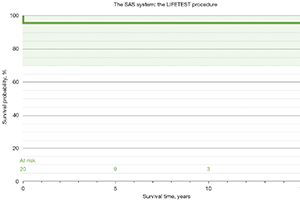Outcomes of cardiothoracic surgery in women with Turner syndrome
Abstract
Background: To describe short- and mid-term surgical outcomes of patients with Turner syndrome (TS) after cardiovascular interventions.
Methods: All individuals >12 years of age at the time of surgical repair for cardiovascular disease (valve or coarctation repairs, aortic disease, aortic dissection) from 2002 to 2022 were eligible. The primary endpoint was complications or death within 30 days of intervention. Secondary outcomes included late complications and reinterventions within six months. Combined data from the University of Texas Health Science Center at Houston and the Turner Syndrome Society of the United States were included in the analysis
Results: We identified 22 patients who met the inclusion criterion. The median age was 46 years (range, 21–75 years), with 86% having estrogen replacement therapy. The most common medical condition was hypertension (77%), followed by hypothyroidism (59%). The most frequent indication for surgery was aortic root or ascending aortic aneurysms (68%), followed by symptomatic aortic stenosis in patients with bicuspid aortic valve (64%), coarctation of aorta (45%), and acute aortic dissection (18%). Respiratory complications were the most common (68%). Pleural effusions were the most frequent found sign on imaging studies (68%). Thoracentesis, or chest tube placement, was required in 33% (5/15). Respiratory failure requiring specific support with high flow oxygen and/or thoracentesis occurred in 36% (8/22).
Conclusions: Patients with TS may be at an increased risk for postoperative complications after aortic surgery. Bicuspid aortic valve (59%) and coarctation of the aorta (45%) were the most common congenital malformations among our study group. Our study showed that respiratory complications were the most common, with pleural effusions being the most common post-surgery complication.
Cover






